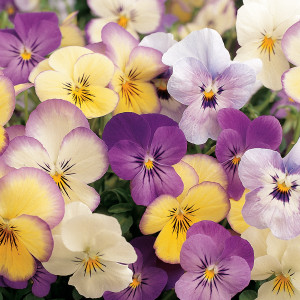 The production of Pansies and Violas in the often hot temperatures of early fall presents many serious challenges for the grower. This page is designed to present some of the current information available for the grower to produce a healthy and successful crop. Also included on this page will be what we apply to your crop that may have a bearing on your program.
The production of Pansies and Violas in the often hot temperatures of early fall presents many serious challenges for the grower. This page is designed to present some of the current information available for the grower to produce a healthy and successful crop. Also included on this page will be what we apply to your crop that may have a bearing on your program.
The origin of modern Pansies are credited to the work of an English Lord in the early 1800’s. Crossing the Alpine European species of V. tricolor (Johnny-Jump-up) and lutea with the Russian species of altaica began the modern hybrid Pansy. Where the climate is mild enough throughout the year Pansies can be a perennial though in most parts of the US they are treated as an annual. They have grown in popularity over the past decade to become one of the best selling bedding plants in the US particularly in the fall where their near legendary cold tolerance has become appreciated.
Because the origins of the Pansy arise from plants adapted to cool conditions they grow and flower best at temperatures below 65°F. Warmer conditions than this causes stress in the plants which makes it important to minimize any other forms of stress as much as possible. Included here is a checklist we created for Pansy production for finishing from Speedling plugs:
Ahead of time:
- Media- Check to make sure pH is between 5.0 and 5.5. A low or no nutrient charge is recommended for Pansy production.
- Fertilizer- Avoid high-ammonia based fertilizers. Current guidelines suggest alternating applications of calcium nitrate based feeds such as 13-2-13 with low ammonia feeds such as 20-10-20 gives the best results.
- Water- Should be tested before the season starts. The ideal water source should be less than 700ppm TDS with 60 to 80ppm bicarbonates. Levels above these require extra diligence to prevent undesirable salt build-up and/or pH changes.
- Sanitation- Treat the growing area with disinfectant to help prevent the occurrence of disease causing organisms (such as Black Root Rot). For the same reasons be sure to always use new containers and media for your Pansies.
When you receive your plugs:
- Inspect- Open the boxes promptly when they arrive and check them for any signs of problems. Please notify either Speedling or your broker if you have any concerns.
- Transplant promptly- Acclimatize flats for 24 hours before transplanting keeping them under shade at a minimum of 65 degree nights. After acclimating the flats be sure to transplant promptly. Pansy quality declines quickly once the plugs are mature.
- Location- They should be grown where the night-time temperatures are between 60 and 65 degrees F. Night temperatures above 68 degrees F will encourage tall and poorly branched plants. In warm climates in early fall transplantings benefit from 20 to 40% shade for the first 7 to 10 days to help keep them cool. Otherwise be sure to grow them in full sun.
- Watering- Initially when irrigating do not saturate media when you water. Pansy root growth suffers under long periods of saturation. They should be allowed to dry out before being irrigated again but should not be dried out to the point of wilting.
Afterwards:
- Fertilization- Do not feed for first 2 or 3 days to allow roots to grow out. If there is a nutrient charge in the media do not begin feeding for the first 7 to 10 days. You should be seeing roots growing out of the plug after the first 2 or 3 days. Pansies are considered a low nutrient crop be sure to feed but do not overdo it. 125ppm N based on a constant feed program is a recommended starting point, increase the rate if the potential for heavy leaching occurs such as field growing.
- Monitor pH and salts- Do weekly tests of media to track development and catch early signs of nutrient problems. Foliar testing is also recommended to insure your plants are getting the right level of nutrients.
- Minimize Stress- High temperatures in the early fall season opens the door for nutrient deficiencies (such as Boron deficiency) and diseases such as Black Root Rot. Try to keep all forms of stress (temperature, moisture, nutrition) to a minimum.
- Disease Prevention/Sanitation- Scout weekly for pale colored or slow growing individuals. Check for dark colored roots and/or crown rot. If found, discard those pots promptly. Preventative fungicide programs generally are more effective than those based on curative (after the disease is present). Your plugs from Speeding will have been treated with an application of Plantshield (a biological fungicide) and a Cleary’s 3336/Subdue drench.
- Finish Times- Depending on time of year, container size and market specifications it should take between three to seven weeks to finish your containers from a Speedling plug.
